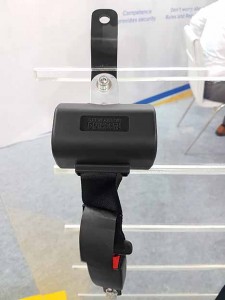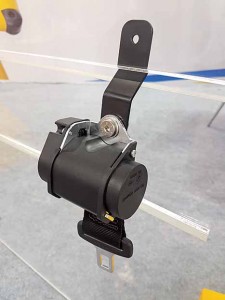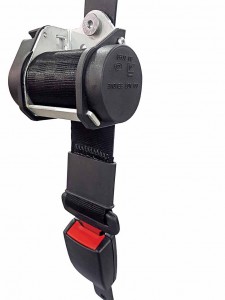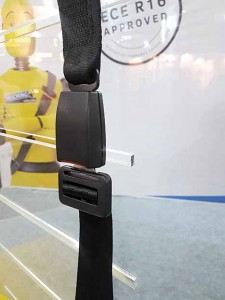Fasching Salzburg is working towards manufacturing seat belts in India to cater to the domestic and other South East Asian markets.
Story by: Bhargav TS
Fasching Salzburg GmbH was established in 1987 in the Austrian city of Salzburg as a small family business to manufacture safety belts. The period between 1987 and 1989 led the company to grow rapidly in-line with the retrofitting obligation for safety belts in Italy. This growth fuelled expansion, and Fasching in 1990 took a strategic decision to relocate its manufacturing activities to Sopron, Hungary. It is here that the company came to possess a high-quality and affordable manufacturing base for safety belts and components. Beginning to supply safety belts to OEMs in 2000 for passenger seats of buses and commercial vehicles as per the statutory regulations that dictated their use, Fasching embarked on yet another stage of expansion. This time, its strategy took it to the international markets the world over. It is for some time now that Fasching has been supplying safety belts in India.
Local manufacture
To underline its commitment for the Indian market, the company is working towards setting up a manufacturing facility in India. The aim is to serve the domestic market as well as the other South East Asian markets like Malaysia, Vietnam, Indonesia and Thailand. Specialising in the design, development and manufacture of safety belts mainly for wheel chair applications apart from commercial vehicles, the company is looking at leveraging the frugal engineering qualities associated with manufacturing in India. Fasching is expected to manufacture a wide range of safety belts in India among those that it offers globally. The product range of the company includes two-point, three-point and special belts in different versions and technologies like static, ALR, ELR and buckles. The range also includes automatic locking retractors, emergency locking retractors, two-point belt systems, three-point belt system, and special solutions like H-belts, bicycle tethers, fall protection belts, YoYo belts and five-point belt systems.
Supplying seat belts in India for the last four to five years, the company, according to Harald Pessl Ing, Sales Director and Authorised Officer, Fasching Salzburg GmbH, is looking at India as a switch to broadcast the business prospects. “Keeping India as a base, we could cover the South East Asian markets. Setting up a manufacturing base in India will open new avenues for us,” Expressed Harald. Fasching, in India, has supplied 60,000-80,000 seat belts over the last four to five years. This clearly indicates that India is one of the promising international markets for the company, which currently has just one manufacturing facility in Europe. Averred Harald, “To begin with, we would target the commercial vehicle segment, and buses especially, as this zone has huge numbers. We are planning to localise 99.9 per cent as this will give us a cost advantage. We would also be tagged as one of the local suppliers.”
Aiming for sustainable growth
Fasching, it is clear, is not hurrying into its strategy to setup a manufacturing operation in India. It is working on a sustainable growth model instead. It is keen to ensure that its seat belts do not earn a bad name for reasons that may not have to do with the belts, but with other factors involved. The design and layout of the seat for example. Planning to produce seat belts with technical inputs from the parent company and supply them to buses, mini buses and mini vans, Fasching is targetting tier-one and tier-two suppliers. Close to 80 per cent of what the company supplies, goes to tier-two suppliers. Another 15 per cent goes to tier-one suppliers. The remaining five-per cent, according to Harald, is equally balanced. “We are supplying safety products to the customers,” mentioned Harald. He said, “We will work with seat manufacturers on how to structure the seat, position the retractor and make it function flawlessly.” The function of passenger seat belts in a bus amounts to a complex operation. It goes to work in sync with various seat functions and seat designs. Any shortcoming in seat design or seat function can hamper the function of the seat belt. “Unless we get the required layout, our seat belt will not function properly. As we sell a safety product, we need to doubly verify before we proceed with order book instructions,” said Harald.
The Indian market, opined Harald, is still at a nascent stage in the adaptation of safety products as a stand-alone feature. This is despite seat belts being made mandatory for passenger cars, he added. “It would have been better if the regulation was extended to buses, especially inter-city buses, with a deadline for compliance”. Harald felt that it were the manufacturers of buses like Mercedes-Benz and Volvo among others who could direct the Indian market to set high standards in safety with the use of passenger seat belts. “We can only manufacture and supply the product. As an extended move we could explain our product needs with certain videos. The difference between two-point and three-point seat belts could be explained for example. Beyond that much depends on market awareness and regulations,” said Harald. Interestingly, the ratio of two-point seat belts and three-point seat belts was 70:30 in 2004-2005. Today it is 50:50, and mandated as per the European norms. India, opined Harald, could look at a similar structure, albeit agressively, where four years down the line, a 20:80 (two-point : three-point seat belts) ratio is achieved.
Passenger seat belt culture in Indian buses
In the near-term, the company is not expecting a drastic change in demand for commercial vehicle seat belts. It is perhaps because of this that Fasching is open to looking at the passenger car segment for growth. “Passenger car segment seat belts does not involve rocket science. We have capabilities to produce such seat belts except for the pretensioners. Pretensioners are however found only on some premium cars like BMW, Audi, Mercedes-Benz and Volvo. Smaller car segments do not have them. Though car segment is not going to be our immediate priority, we are open to look at it,” informed Harald. He signed off by saying that he is hopeful of inter-city buses in India being mechanised with seat belts soon.























